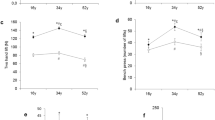Summary
The physical working capacity (PWC) of 303 male adolescents was measured using the PWC170 test. The changes in PWC with age were similar to those reported by other workers; the PWC of male adolescents in Ireland appears to be similar to that of North American subjects and may be somewhat lower than that of subjects in some other parts of the world. There was no evidence to suggest a relationship between PWC and level of habitual activity in the younger subjects but heavy physical activity was found to be related PWC in post adolescents.
Similar content being viewed by others
References
Adams, F. H., Bengtsson, E., Berven, H. and Wegelius, C. 1961. Physical working capacity of normal school children. Paediatrics, 28, 243.
Astrand, P-O. 1952. Experimental studies of physical working capacity in relation to sex and age. Copenhagen, Munsgaard.
Bengtsson, E. 1956. The working capacity in normal school children evaluated by submaximal exercise on bicycle ergometer and compared with adults. Acta Medica Scand. 54, 91.
Blumcheu, G., Roskamm, H. and Rendall, H. 1966. Herzvolumen und korperliche leistungsfahigkeit. Kreislaufforschung, 55, 1012.
Buskirk, E. and Taylor H. L. 1957. Maximum oxygen uptake and its relation to body composition. J. Appl. Physiol. 11, 72.
Capher, 1968. The physical working capacity of Canadian children. Toronto, Canadian Association of Health, Physical Education and Recreation.
Cumming, G. R. and Cumming, P. M. 1963. Working capacity of normal school children tested on a bicycle ergometer. Canad Med. Ass. J. 88, 351.
Cumming, G. R., Goodwin, A., Baggley, G. and Antel, J. 1967. Repeated measurements of aerobic capacity during a week of training at a youths track camp. Canad. J. Physiol. and Pharmacol. 45, 805.
Cumming, G. R., Goulding, D. and Baggley, G. 1969. Failure of school physical education to improve cardio respiratory fitness. Canad. Med. Ass. J. 101, 69.
Cureton, K. J., Boileau, R. A. and Lohman, T. G. 1975. A comparison of densiometric, potassium 40 and skinfold estimates of body composition in pre pubescent boys. Human Biology, 47, 321.
Davies, C. T. M., Barnes, C. and Godfrey, S. 1972. Body composition and maximum exercise performance in children. Human Biology, 44, 195.
Dempsey, J. A., Reddan, W., Balke, B. and Rankin, J. 1966. Work capacity determinants and weight supported cost of work in obesity. J. Appl. Physiol. 21, 1815.
Durnin, J. V. G. A. and Passmore, R. 1967. Energy, work and leisure. London. Heinemann.
Durnin, J. V. G. A. and Rahaman, M. M. 1967. The assessment of the amount of fat in the human body from measurements of skinfold thickness. Br. J. Nutr. 21, 681.
Edholm, O. G. 1966. Assessment of habitual activity. In “Physical Activity in Health and Disease”. Ed. K. Egang and K. L. Anderson. Norway, Oslo University Press.
Knutten, H. G. 1967. Aerobic capacity of adolescents. J. Appl. Physiol. 22, 655.
Larson, L. A. 1974. Fitness health and work capacity. New York, MacMillan.
Matsui, H., Miyashita, M., Miura, M., Kobayshi, K., Hoshikowa, T. and Kamei, S. 1972. Maximum oxygen intake and its relation to body weight of Japanese adolescences. Med. and Sci. in Sports. 4, 29.
Parizkova, J. 1968. Longitudinal study of the development of body composition in boys of various levels of physical activity. Human Biology, 40, 212.
Robinson, S. 1938. Experimental studies of body composition in relation to age. Arbeitsphysiol. 10, 251.
Rutenfrantz, J. 1964. Entwicklung und beurterlung der korperichen leistungsfahigkett bei kendern und jugendlichen. Bibliotheca Paediatrica, 82, Basel, Karger.
Saltin, B., Blomqvist, G., Mitchell, J. H., Johnson, R. L., Wildenthal, K., Chapman, C. B. 1968. Response to exercise after bed rest and after training. Heart Ass. Mon. 23, 1.
Seliger, V. and Pachlopnikon, I. 1967. Vergleicheurde ergometrische Undersuchunger bei den Gymnastikturnern. 2nd Int. Sem. Ergonom., Berlin.
Shephard, R. J. 1971. The working capacity of school children. In “Frontiers of Fitness”, ed. R. J. Shepherd. Springfield, Thomas, p. 319.
Shephard, R. J. 1969. Endurance fitness. Toronto, University of Toronto Press.
Sjostrand, T. 1947. Changes in the respiratory organs of workmen at an ore smelting works. Acta Medica Scand. Suppl. 196, 687.
Wahlund, H. 1948. Determination of physical working capacity. Stockholm, Zetterlund und Thelanders Boktryckeri A-B.
Watson, A. W. S. and O’Donovan, D. J. 1976. The reliability of measurements of PWC170. Ir. J. Med. Sci. 145, 307.
Author information
Authors and Affiliations
Rights and permissions
About this article
Cite this article
Watson, A.W.S., O’Donovan, D.J. The physical working capacity of male adolescents in Ireland. IJMS 145, 383–391 (1976). https://doi.org/10.1007/BF02938977
Issue Date:
DOI: https://doi.org/10.1007/BF02938977




